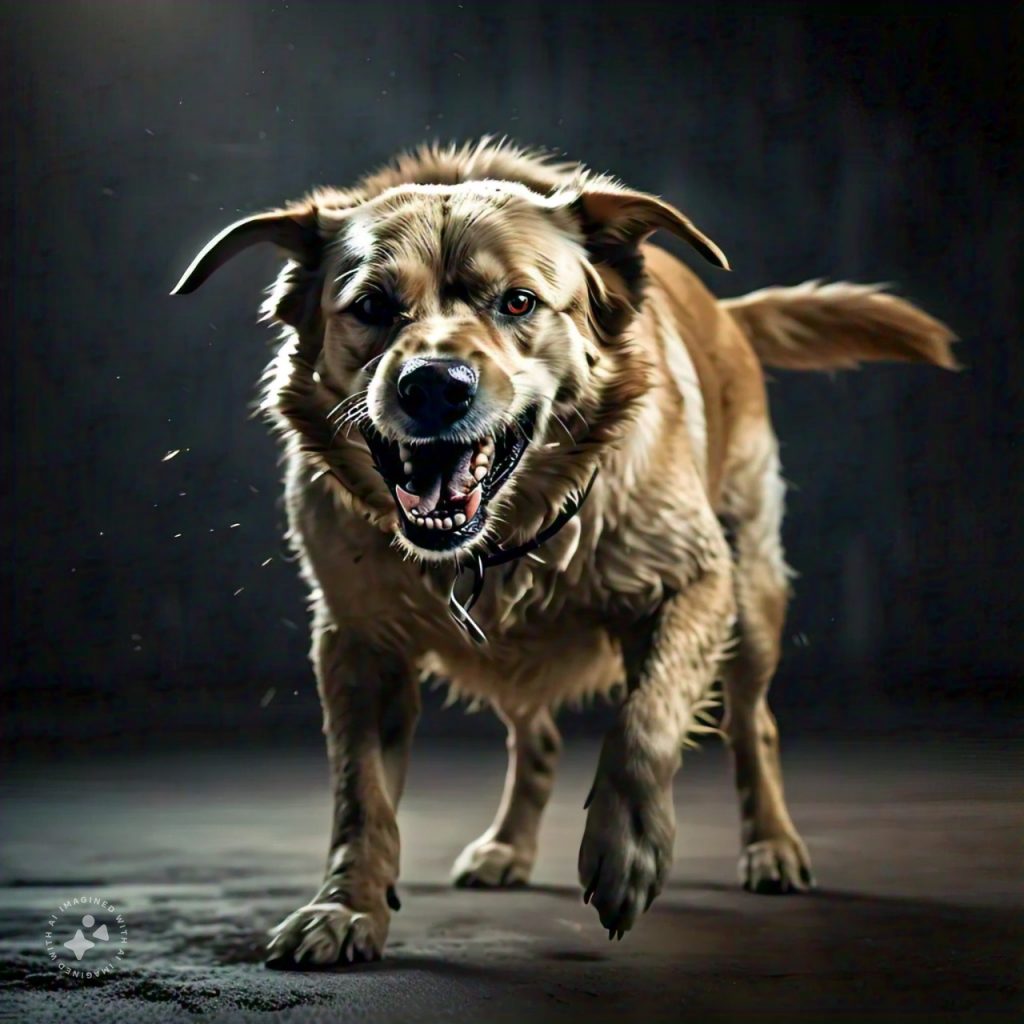What Is Aggression in Dogs?
Aggression is defined as threatening or harmful behavior directed toward another individual, whether a person, animal, or object. It can range from subtle signs like stiff body language to overt actions such as lunging or biting.
Types of Aggression in Dogs
Understanding the type of aggression your dog is displaying is crucial for managing it effectively. Common types include:
1. Fear-Based Aggression
- Triggered by perceived threats.
- Common in dogs with poor socialization or traumatic experiences.
- Signs include cowering, retreating, or snapping when approached.
2. Territorial Aggression
- Directed at individuals perceived to be intruding on the dog’s space.
- Often seen in dogs guarding their home or yard.
- Barking, lunging, or charging at strangers are typical behaviors.
3. Resource Guarding (Possessive Aggression)
- Occurs when a dog defends food, toys, or other valued items.
- Signs include growling, snapping, or stiff posture when approached near their possessions.
4. Pain-Related Aggression
- Triggered by physical discomfort or medical conditions.
- Dogs in pain may react aggressively to avoid handling or movement.
5. Social Aggression
- Occurs in multi-dog households when dogs compete for dominance or resources.
- Signs include growling, snapping, or fighting.
6. Predatory Aggression
- Related to the instinct to hunt prey.
- Involves stalking, chasing, or attacking smaller animals.
7. Maternal Aggression
- Seen in nursing mothers protecting their puppies.
- Temporary and typically resolves as puppies grow.
8. Redirected Aggression
- Occurs when a dog cannot reach its intended target and redirects its frustration to a nearby individual or object.
Causes of Aggression in Dogs
Aggression rarely stems from a single factor. It often results from a combination of the following:
1. Lack of Socialization
Dogs not exposed to various environments, people, or animals during their formative months may struggle to handle unfamiliar situations.
2. Fear or Anxiety
Past trauma, abuse, or a lack of confidence can lead to fear-based aggression.
3. Medical Issues
Pain, neurological disorders, or hormonal imbalances can trigger aggression. Common medical causes include arthritis, thyroid imbalances, or brain injuries.
4. Genetics
Certain breeds or individual dogs may have a predisposition toward aggressive behavior due to their genetic makeup.
5. Learned Behavior
Dogs may learn that aggression achieves desired outcomes, such as avoiding punishment or threats.
6. Frustration
Barriers, such as fences or leashes, can lead to frustration that manifests as aggression.
Signs of Aggression in Dogs
Identifying aggression early can prevent escalation. Key warning signs include:
- Body Language: Stiff posture, raised hackles, intense staring, or tucked tail.
- Vocalizations: Growling, snarling, or excessive barking.
- Physical Actions: Lunging, snapping, or biting.
How to Address Aggression in Dogs
1. Consult a Veterinarian
If your dog shows signs of aggression, schedule a veterinary visit to rule out medical causes. Pain, illness, or hormonal issues might be contributing factors.
2. Identify Triggers
Keep a journal of incidents to identify patterns or triggers, such as specific people, animals, or environments.
3. Work with a Professional
Engage a certified dog trainer or animal behaviorist who specializes in aggression. They can design a customized behavior modification plan.
4. Desensitization and Counterconditioning
Gradually expose your dog to triggers in a controlled environment while associating them with positive experiences (e.g., treats or praise).
5. Practice Consistent Training
Basic obedience training can improve your dog’s responsiveness and establish you as a confident, calm leader.
6. Avoid Punishment
Yelling, hitting, or other forms of punishment can worsen aggression by increasing fear or stress.
7. Manage the Environment
- Use barriers like baby gates or leashes to prevent incidents.
- Avoid high-stress situations, such as crowded areas or dog parks, if your dog struggles with aggression.
8. Provide Mental and Physical Stimulation
- Daily exercise and enrichment activities reduce stress and boredom, common contributors to aggression.
- Puzzle toys, scent work, or agility training can redirect your dog’s energy.
Prevention Strategies
- Early Socialization: Introduce puppies to various people, animals, and environments to build confidence and adaptability.
- Spaying/Neutering: May reduce hormone-driven aggression.
- Routine Vet Care: Regular check-ups ensure health issues are identified early.
- Proper Training: Teach commands like “sit,” “stay,” or “leave it” to improve control in challenging situations.
When to Seek Immediate Help
- Biting or Attempted Biting: Any incident involving a bite should be addressed immediately by a professional.
- Escalating Behavior: If aggression becomes more frequent or severe.
- Fear for Safety: If the dog poses a danger to people or other animals.
FAQs About Dog Aggression
Can Aggression in Dogs Be Cured?
Aggression can often be managed but not completely “cured.” Success depends on the underlying cause, the dog’s temperament, and the owner’s commitment to training.
Are Certain Breeds More Aggressive?
While some breeds are predisposed to protective or territorial behaviors, aggression is influenced more by individual temperament, training, and environment than breed alone.
What Should I Do if My Dog Bites Someone?
Stay calm, secure your dog, and attend to the victim’s needs. Report the incident if required by local laws and consult a professional immediately.
Conclusion
Aggression in dogs is a multifaceted issue that requires a proactive and compassionate approach. By understanding its causes and addressing it with proper training, professional guidance, and consistent care, you can improve your dog’s behavior and strengthen your bond. Remember, patience and persistence are key to helping your dog lead a happier, safer life.

